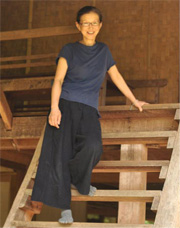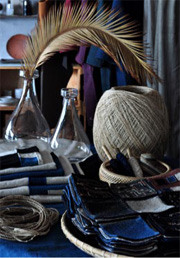Home > Highlighting JAPAN > Highlighting Japan FEBRUARY 2013 > A Life in Love with the Fabrics of Laos
Highlighting JAPAN
[SERIES] JAPANESE ABROAD
A Life in Love with the Fabrics of Laos
Yukiko Tani lives in Laos, Southeast Asia, where for more than ten years she has been hand-making fabrics with minority ethnic groups. Osamu Sawaji of The Japan Journal reports.

Yukiko Tani in the HPE office in the village of Luang Namtha.
Credit: KAZUTO KOBAYASHI
"They harnessed the gifts of nature and used their intelligence and physical strength to provide everything they needed to live. I thought that these people were truly independent," says Tani. "I was deeply impressed by them."
Tani was particularly fascinated by the fabrics which the women of the different ethnic minority groups make by hand, even more so because they made these clothes for nothing or for barter. At the time, Luang Namtha was already becoming a money-based economy and a society where the villagers could easily be selling their clothes for money.
"Anyone used to be able to make fabrics and clothes, but it is a skill that is now disappearing from the world," says Tani. "The techniques used here were like 'a living fossil.' As the money-based economy was developing, I wanted these women to become a part of it using the power in their handiworks which they had not yet recognized. I too wanted to be involved in this."

Coasters (front right), knotted cord (front left), and furoshiki wrapping cloth (back left). Theses products of HPE are wholesaled and sold at the shop such as OUTBOUND in Tokyo.
Credit: KAZUTO KOBAYASHI
Initially frustrated because she was unable to speak any of the local language, Tani began to study, communicating at first with a dictionary in her hands. Proving that people have a great capacity to understand that goes beyond language, Tani was able to make clothes through a process of trial and error. It was, she says, the happiest moment when, with the blessing of nature and of the villagers, she was able to make clothes from the beginning of the fabric-making process to the finished product.
At times, she says, she also harnessed old techniques from Japan. When she urgently needed to increase production of twisted silk yarn, while visiting Japan she happened upon a yarn-twisting machine that had been made at the end of the Edo period (1603–1867). This twisting machine worked on the same principle as the machines that were being used at the time in Luang Namtha, but it had a far greater capacity. What is more, because it was hand-operated, it could be used in a village without access to electricity. Tani transported two machines to Laos with the assistance of a Japanese apparel company. The villagers used these as a model to produce twisting machines themselves, significantly increasing twisted yarn production.

A woman weaving yarn
Credit: KAZUTO KOBAYASHI
Take, for example, the coasters made by the Lenten people. The villagers are free to embroider the indigo-dyed cotton cloth as they wish, and no two coasters are the same.
"I felt the products had to be small and fun to sell. I ask the Lenten people to embroider freely, without assigning specific designs, using their own embroidery skills. Some designs are quite elaborate while others are more rough. I buy them all, but the prices I pay differ according to their traits. In this way the embroiderers can decide by themselves what they should make," says Tani. "The number of coaster makers has increased without me even asking. For the villagers, the work is easy and fun, and they find it stimulating that the prices I pay differ depending on their efforts. Men and women of all ages began making coasters to earn spending money for sweets or cigarettes."
Luang Namtha, where Tani has now lived for over ten years, is in the middle of a big change. Construction to widen paved roads is underway everywhere. The public buildings and private houses in villages are being rebuilt in modern styles.
"It is very difficult to hand down handiwork techniques in the middle of such development. But human beings originally spent their lives making use of their physical ability with the blessing of nature. I wonder if we should abandon such power," says Tani. "I really love the handiworks of the villagers and want to hand down their techniques. To do so, I feel I will be able to find a beam of hope depending on how closely I can stick to the basics when making fabrics. That's my challenge."
© 2009 Cabinet Office, Government of Japan






